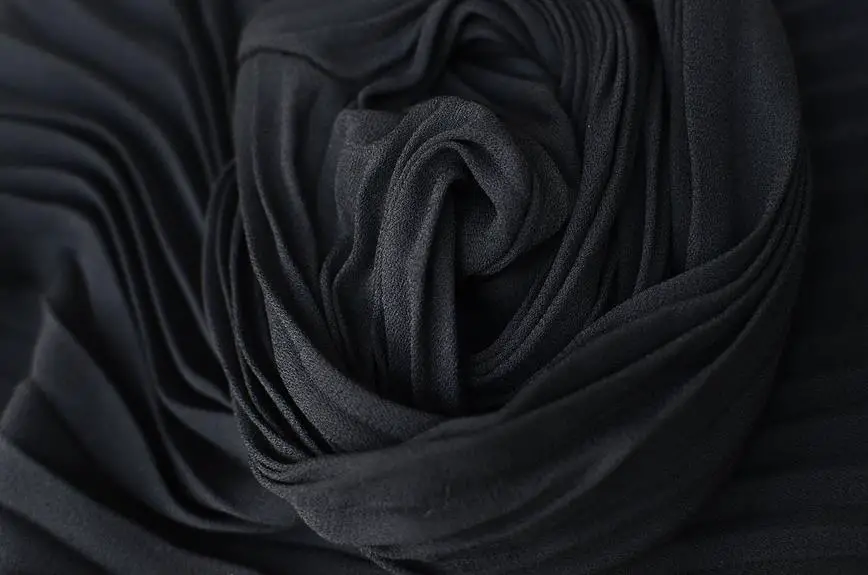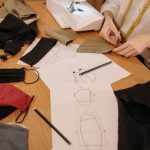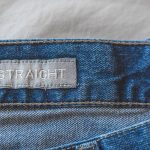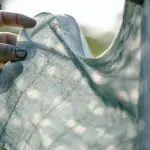Think you know everything about dressmaking? Think again!
Understanding these 10 essential dressmaking terms will take your skills to the next level.
From backstitch and basting stitch to bias binding and gathering, mastering these terms is a must for any serious dressmaker.
Let's dive in and make sure you're familiar with these key concepts.
Key Takeaways
- Understanding dressmaking terms is essential for achieving a professional finish.
- Dressmaking terms enhance dressmaking skills and ensure durability and neatness.
- Using dressmaking terms creates a polished appearance and improves garment construction.
- Mastering techniques like French seams contributes to a refined and polished aesthetic.
Backstitch
Backstitch provides reinforcement to your seams, ensuring durability and strength in your dressmaking projects. This stitching technique involves sewing backward and then forward in the same place to secure the stitches. By backstitching, you prevent the seams from unraveling and increase the overall longevity of your garment. It's a fundamental skill in dressmaking, especially when working with fabrics that are prone to fraying or under high stress.
Mastering backstitching opens up creative applications in your sewing projects. Beyond its primary function of reinforcing seams, you can use backstitching decoratively to add texture or visual interest to your garments. For instance, creating intricate patterns or outlines with backstitching can elevate the design of your clothing, making it a versatile technique for both practical and aesthetic purposes.
Incorporating backstitching into your repertoire of stitching techniques equips you with the ability to enhance the quality and resilience of your dressmaking endeavors. Whether you're crafting everyday wear or special occasion garments, understanding and proficiently applying the backstitch will undoubtedly elevate the durability and visual appeal of your creations.
Basting Stitch
So, let's talk about the basting stitch.
It's a temporary stitch that uses long, loose stitches to secure fabric for sewing.
This type of stitch is easily removed after the sewing is done, making it a helpful technique in dressmaking.
Temporary Stitch Uses Long
When basting a garment, you'll use a long temporary stitch known as a basting stitch. This long stitch is essential for holding fabric layers together temporarily, allowing you to check the fit and make adjustments before sewing permanent seams.
Using hand sewing techniques, you can create basting stitches with a contrasting thread color to differentiate them from permanent stitches, making it easier to remove them later. The length of the basting stitch can vary depending on the fabric and the purpose of basting, but it's generally longer than regular machine stitches.
Remember to secure the beginning and end of the basting stitch to prevent unraveling. Mastering the art of basting stitches will enhance your dressmaking skills and ensure precise and professional results.
Secures Fabric for Sewing
To secure fabric for sewing, you'll utilize a basting stitch, which uses a long temporary stitch to hold fabric layers together temporarily.
When mastering this technique, remember to consider fabric manipulation and draping to achieve the desired fit and form. It's crucial to perfect pattern cutting for precise basting, ensuring the fabric aligns seamlessly.
Additionally, understanding garment construction plays a significant role in creating a foundation for successful basting.
As you practice this skill, pay attention to the tension of the basting stitch to prevent puckering or gathering of the fabric.
Lastly, take the time to appreciate how the basting stitch contributes to the overall quality and professional finish of your dressmaking projects.
Easily Removed After Sewing
You can easily remove a basting stitch after sewing by gently pulling the temporary stitches out of the fabric. Basting stitches are long, temporary stitches used to hold fabric in place before permanent sewing. To remove them, simply grasp the end of the basting thread and gently pull.
This technique is especially useful for seam reinforcement and fabric manipulation, as it allows you to easily adjust or remove stitches without causing damage to the fabric. Mastering this stitch removal method is essential for refining your sewing techniques and achieving professional-looking results.
Whether you're basting a seam for fitting purposes or securing fabric layers for intricate manipulations, knowing how to easily remove basting stitches will streamline your dressmaking process.
Understitching
Ready to take your dressmaking skills to the next level? Let's talk about understitching.
This technique is crucial for achieving professional-looking results and can make a significant difference in the overall finish of your garment.
Let's go over the importance of understitching and the key steps for mastering this essential dressmaking term.
Importance of Understitching
Understitching is an essential technique in dressmaking that helps to create a professional and polished finish on the inside of garments. It's a crucial step in ensuring that facings and linings stay in place and don't roll to the outside of the garment, maintaining a neat and tidy appearance.
Here's why understitching is important:
- Prevents edges from rolling out, ensuring a clean and professional look
- Helps the garment to lay flat and drape nicely on the body
- Enhances the durability of the garment by securing the layers together
- Adds a high-quality, refined finish to your dressmaking projects
- Elevates the overall look of the garment, giving it a more expensive and tailored appearance
Mastering understitching will undoubtedly elevate the quality of your dressmaking projects.
Steps for Understitching Success
When achieving understitching success, use the appropriate sewing machine foot for precision and control. The edge-stitching foot or the specialized understitching foot can help maintain a consistent distance from the edge, resulting in a professional finish.
Prior to understitching, ensure that the seam allowance is pressed towards the facing to allow for easy manipulation. It's crucial to use pressing techniques to set the seam and facing properly.
While understitching, carefully manipulate the fabric to avoid any wrinkles or puckers. Additionally, pattern drafting and fitting adjustments are essential for achieving the best results with understitching. Properly fitted patterns will ensure that the facing and main fabric align correctly, making understitching more effective.
Seam Allowance
Once you have selected your pattern and fabric, you'll need to consider the seam allowance for each piece before cutting. Seam allowance is the extra fabric between the stitching line and the raw edge of the fabric, and it's crucial for ensuring that your garment construction is sturdy and well-finished.
Here are some essential points to keep in mind regarding seam allowance:
- Consistency is Key: Maintain a consistent seam allowance throughout your garment to ensure a professional and polished finish.
- Pressing Technique Matters: Properly press your seam allowances to one side or open, following the pattern instructions, for a neat and professional look.
- Choose the Right Stitch Length: For seam construction, use a standard stitch length on your sewing machine to secure the seam without creating unnecessary bulk.
- Consider Finishing Techniques: Seam allowances can be finished with techniques such as zigzag stitching, pinking, or serging to prevent fraying and add durability to your garment.
- Practice Precision: Accurately measuring and cutting your seam allowance is essential for achieving the perfect fit and ensuring that your garment comes together flawlessly.
Understanding and implementing these seam allowance fundamentals will elevate the quality of your dressmaking projects.
French Seam
You may have heard about the French seam, but do you know how it can elevate your dressmaking game?
This seam finishing technique creates a clean, double-stitched edge that adds a professional and polished look to your garments.
It's a simple yet effective way to give your sewing projects a high-end finish.
Seam Finishing Technique
To achieve a professional-looking finish on your seams, consider using the French seam technique. This method involves enclosing raw edges within the seam for a neat and polished look. Here are a few key points to keep in mind when using this seam finishing technique:
- Provides a clean and elegant finish to your garments
- Ideal for lightweight fabrics such as chiffon and silk
- Adds durability to the seams, preventing fraying over time
- Creates a smooth and comfortable feel against the skin
- Offers a professional touch to your dressmaking projects
Mastering the French seam technique will elevate the quality of your garments and showcase your attention to detail in dressmaking.
Double-Stitched Clean Edge
The double-stitched clean edge, also known as the French seam, is a versatile and professional finishing technique used in dressmaking. This seam finishing method encases raw fabric edges within two lines of stitching, resulting in a neat, durable, and elegant seam.
The French seam is ideal for lightweight and sheer fabrics, as it prevents fraying and adds a polished touch to your garment. It's especially useful for fabric manipulation techniques and creating clean lines in creative designs.
When utilizing the French seam, ensure that your sewing machine is well-maintained. Regular cleaning, oiling, and timely troubleshooting will guarantee smooth and precise stitching, essential for achieving impeccable French seams.
Mastering this seam finishing technique will elevate the quality and aesthetic appeal of your dressmaking projects.
Professional and Polished Look
Achieve a professional and polished look in your dressmaking projects by mastering the French seam finishing technique. French seams are perfect for delicate fabrics and create a neat, clean finish on the inside of the garment.
To elevate your dressmaking projects and achieve a polished look, consider the following:
- Fabric Selection: Choose high-quality fabrics that drape elegantly and are suitable for French seam finishing.
- Color Coordination: Pay attention to color coordination to create a cohesive and sophisticated look.
- Accessory Pairing: Select accessories that complement the style and fabric of the garment for a polished ensemble.
- Outfit Styling: Experiment with different styling options to enhance the overall appearance and create a professional look.
Mastering the French seam technique won't only elevate the quality of your dressmaking projects but also contribute to a refined and polished aesthetic.
Hemming
Are you familiar with the term 'hemming' in dressmaking? Hemming is the process of finishing the raw edge of a fabric by folding, pressing, and stitching it in place. To achieve professional and polished results, it's essential to master hemming techniques and best practices.
There are different types of hems, each serving a specific purpose. For lightweight fabrics, a narrow rolled hem is ideal for creating a delicate finish. A blind hem, on the other hand, is perfect for creating nearly invisible hems on garments with straight, unbroken hems. When working with heavier fabrics, a wide or deep hem provides weight and stability to the garment.
Understanding when to use each type of hem is crucial for achieving a high-quality finish on your dressmaking projects. By incorporating these hemming techniques and choosing the appropriate hem for each garment, you can elevate the overall look and feel of your creations. Mastering the art of hemming will undoubtedly contribute to the professional quality of your dressmaking endeavors.
Dart
When working on your dressmaking projects, it's important to understand the purpose and function of a dart. Darts are essential for creating shape and a proper fit in garments, and mastering dart manipulation and placement is crucial for achieving professional-looking results. Here are some key points to consider:
- Dart manipulation allows you to adjust the pattern to better suit your body shape, ensuring a more customized fit for your garments.
- Understanding dart placement is vital for achieving the desired garment shaping, whether it's for a fitted bodice, tailored trousers, or structured skirts.
- Proper dart positioning can make a significant difference in how well a garment flatters your silhouette, so it's worth taking the time to learn about different dart placements.
- Mastering pattern adjustment through darts empowers you to modify commercial patterns to better fit your body, giving you the freedom to create personalized, well-fitted clothing.
- Experimenting with dart manipulation and placement can lead to more sophisticated and elegant designs, adding a touch of professional finesse to your dressmaking projects.
Understanding darts and how to manipulate them will elevate the quality and fit of your handmade garments, allowing you to create pieces that showcase your mastery of dressmaking.
Gathering
To achieve a gathered effect in your dressmaking projects, consider using a gathering foot attachment on your sewing machine. This attachment allows for easy fabric manipulation, making the process of gathering fabric quicker and more precise. Gathering involves evenly distributing fabric across a larger area, creating a soft, flowing look. It's a versatile technique that can be used to add decorative elements to garments, such as ruching, which adds texture and visual interest.
When using a gathering foot attachment, simply adjust the tension and stitch length on your sewing machine to control the fullness of the gather. This creative technique can be applied to various parts of a garment, such as sleeves, waistlines, or skirts, to add volume and movement. Experiment with different fabrics and gather densities to achieve unique and eye-catching effects in your dressmaking projects.
With practice, you'll master the art of gathering and be able to incorporate this elegant technique into your sewing repertoire.
Staystitching
You can use a similar approach to achieve staystitching, an essential technique for stabilizing curved or diagonal garment edges and preventing them from stretching out of shape during the construction process. By mastering this fundamental skill, you can ensure that your garment retains its shape and structure throughout the sewing process.
Here are some key points to consider when it comes to staystitching:
- Fabric Stability: Staystitching helps maintain the stability of the fabric, especially along curved and diagonal edges, preventing distortion during sewing and handling.
- Stitch Techniques: Understanding different stitch techniques for staystitching, such as using a regular straight stitch within the seam allowance, can significantly contribute to the stability of the fabric edges.
- Sewing Preparation: Incorporating staystitching into your sewing preparation routine ensures that the fabric edges are secured before further construction, allowing for smoother and more precise assembly.
- Garment Construction: Staystitching plays a crucial role in the initial stages of garment construction, providing a solid foundation for subsequent sewing processes.
- Preventing Distortion: Implementing staystitching as part of your sewing practice helps prevent distortion and misshaping of garment pieces, resulting in a more professional and polished finish.
Bias Binding
Bias binding is another essential dressmaking term that you can employ to finish the raw edges of your garment, ensuring both durability and a professional, polished appearance. When working on garment construction, understanding how to manipulate fabric to create bias binding is crucial for achieving a clean and neat finish. Bias binding is made from fabric strips that are cut on the bias, meaning they are cut at a 45-degree angle to the grain of the fabric. This allows the binding to stretch and curve easily around the edges of the garment, making it perfect for finishing armholes, necklines, and hems. Additionally, bias binding adds a decorative touch to your garment, enhancing its overall aesthetic appeal.
Consider using bias binding to elevate your dressmaking projects and create a professional look.
| Pros | Cons | Best Used For |
|---|---|---|
| Provides a clean finish | Can be challenging for beginners | Curved edges and necklines |
| Adds a decorative touch | Requires more fabric than other finishing methods | Armholes and hems |
| Offers durability | Requires precision in cutting and sewing | Delicate fabrics |
Understanding how to create and apply bias binding will undoubtedly enhance your dressmaking skills, allowing you to achieve a high-quality finish on your garments.
Frequently Asked Questions
What Are Some Common Mistakes to Avoid When Using a Backstitch?
When using a backstitch, common mistakes to avoid include uneven stitch length and tension. To improve durability, try using smaller stitches. Also, mastering understitching techniques can enhance the overall quality of your sewing projects.
How Can Understitching Improve the Look and Durability of a Garment?
Understitching benefits the look and durability of a garment by preventing facings from rolling out and maintaining a clean edge. To master this garment construction technique, practice stitching close to the seam and pressing the facing toward the inside.
Are There Any Special Techniques for Hemming Different Types of Fabric?
When hemming different fabric types, employ fabric manipulation and special stitches. For delicate fabrics, use rolled hems or blind hems. For heavier fabrics, consider topstitching or hand-sewn hems for durability and aesthetic appeal.
What Are Some Creative Ways to Incorporate Gathering Into Dressmaking Projects?
To incorporate gathering into dressmaking projects, try creative techniques like ruching, shirring, or pleating. These unique designs add depth and texture to your garments. Experiment with different fabrics and placement for a personalized touch.
Can Bias Binding Be Used for More Than Just Finishing Raw Edges?
Yes, bias binding can be used for more than finishing raw edges. It can add decorative flair to garments, like creating piping or straps. It's versatile for various garment construction techniques.
- How Does Ring Spun Cotton Affect Garment Fit and Shape Retention? - August 13, 2024
- What Are the Challenges in Producing Ring Spun Cotton? - August 13, 2024
- Is Ring Spun Cotton Suitable for Plus-Size Clothing? - August 13, 2024







